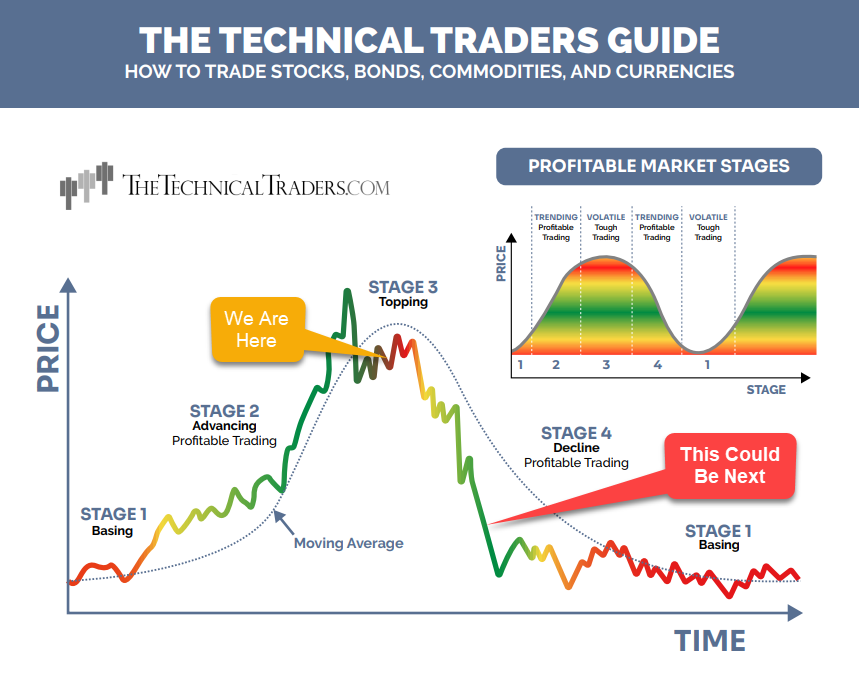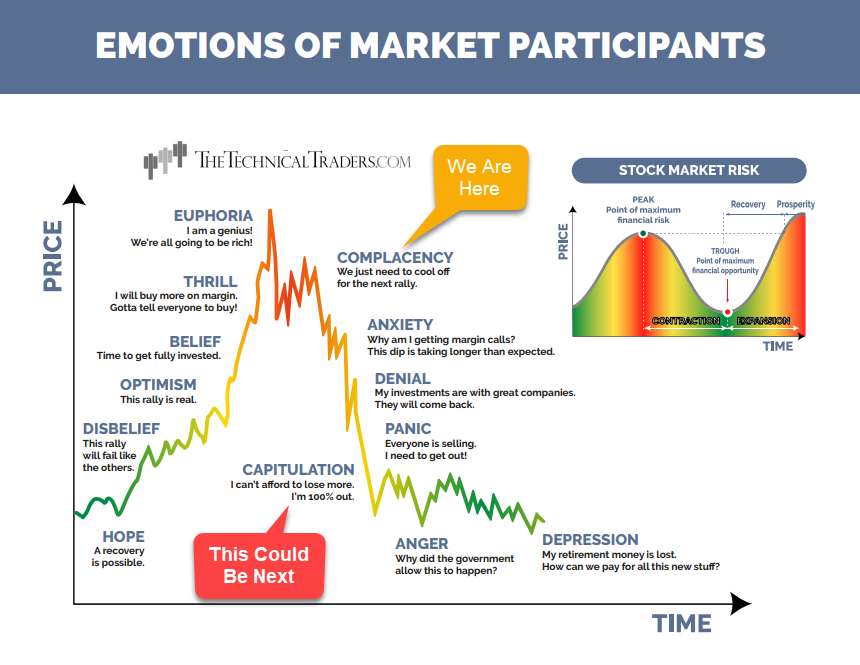How to Prepare for a 37% Crash in 2023 that Won’t Rebound for Years
Recently, I had the opportunity to discuss market and asset class cycles with David Lin from Kitco News, which has gained a lot of attention. I shared my view that we are currently in a complacency phase, not a new bull market phase, and David probed me with some great questions, for which he is well known.
Who I am now
For those of you who don’t know me yet, my name is Chris Vermeulen, and I am a technical trader who bases my analysis on Stan Weinstein’s four-stage analysis of markets. This analysis suggests that we are still in the topping phase (Stage 3), and 2022 was just a warm-up to the start of the next financial reset.

During the course of our chat, I shared with David my belief that though precious metals and miners are leading the way, I feel it’s a false rally. A reset is expected later in 2023 with lower prices across the board for stocks, commodities, and housing, which will provide a great opportunity to accumulate assets in the coming years.
I think of the stock market as an ocean and use different strategies for investing and trading the rising or falling tide, surfing the rallies and corrective moves in price that regularly form like sets of incoming waves. I focus on the big phases of the market and catch the wave-like patterns using various technical analyses such as stages, volume flow, cycles, and market sentiment to determine my entry and exit points. I also stress a lot the importance of setting profit targets and having rules in place to reduce risk. These position and risk management tools allow us to scale out of positions while locking in gains and protecting our capital should the market rollover.
At the time of David’s and my talk, I was holding 100% cash and waiting for the next market signal. He asked me, as a long-term investment signal, what needed to happen before I got bullish. I said that I am waiting for my weekly investing trend chart to turn positive, for consistent money flow to return in specific sectors, and for the trend to turn up before I would open positions once more. Wouldn’t you know it, but all of this came together the day after our interview went live!
How I got there…
My journey in trading started when I was 16 years old in a finance class that issued a stock market challenge. When the semester-long challenge ended, I had made $80,000 in virtual dollars, and that was all it took to hook me in at an early age. These days, I’m a stickler for details and not breaking or bending the rules with my investing because of my training as a pilot when I was a teenager and due to a trading misstep or two along the way.
I was taught the rules and regulations of flying, which you must always remember, and to follow a checklist for each stage of the flight. Failure to do so could result in sudden death or a plunge so swift that it shakes the foundation of who you are and who you want to be. That’s how I now look at my trades and investments – short-haul or long-haul flights with the need to remain focused 100% of the time.
David dug deep, asking about a bad trade I had experienced, how I recovered, and what I learned. I shared a recent one that turned into a $54,000 hit. A long-forgotten investment I had turned into a gold mine (figuratively) when I randomly checked its status – yay for me! And then, like a rookie, I didn’t take profits when I had the chance. I got caught up in the excitement of unexpected ‘free’ money and kept thinking it would go higher. Wow – was I ever wrong. I just fell headlong into the trap that I so often talk about – emotional-based trading and not wanting to sell an asset that is beginning to lose money. So yes, even seasoned traders who know better can make mistakes in their personal accounts.
Though the graphic below is more geared toward the stock market as a whole, it also highlights the emotions we can go through during the lifetime of one trade.

Regretting the whole scenario and lesson without doing something about it is just not my style. So David and I segued into the importance of how knowing your own personality type can turn you into a better trader. I brought up an article I published, how 70% of individuals’ personality types do not favor individuals as self-directed traders or investors, and how a good portion of investors and traders would benefit with help from a newsletter service or advisor.
What I have learned along the way
David made a great observation that people often feel worse when they miss out on gains compared to when they lose money, and I agree. FOMO is a big issue in trading, and people struggle to control their emotions and actions. To help my subscribers with this, I built an indicator that tells us when there is FOMO in the markets and where the price should move next, higher or lower, based on the short-term extreme level.
This interview with David was one of the best interviews I have done. David asked all the right questions for listeners to see the complete picture of how a trader and investor should look at the markets and manage risk and positions, and how to prepare for what could be the perfect storm to destroy any investors future who is 45+ and invested in stocks and bonds. I wrote a detailed article about how investors have Stockholm Syndrome and think wild fluctuations within their retirement accounts are normal and that there is no way to avoid it. But that’s flat-out, not true. For decades, the investment world has had everyone wrapped around their finger doing what they are told about how to invest, and individuals end up getting the short end of the stick.
In short, if you want to know more about what I do and how I can help you keep reading. I share my tactical ETF investment alerts via my CGS newsletter. My disciplined approach helps individuals achieve and maintain their financial and lifestyle goals. For those of you who are tired of the stock market rollercoaster ride, and don’t have the time to ride out a multi-year recovery, it is certainly worth a look.
I trade and invest differently. It’s a significant change from what has been done in the past, and because of that, CGS generates roughly 2-times above-average returns of the 60/40 buy-and-hold method. Moreover, my strategy does this with a fraction of the portfolio volatility compared to traditional investing methods used by firms like Schwab, Fidelity, and financial advisors in general.
Imagine if you could sell your investments as they started to top, then revest the money into different assets rising in value. Imagine never having to hold falling positions again. That’s what I do!
Users follow my email trade alerts in their self-directed brokerage account or have the CGS signals autotraded for them at no additional cost. Recommended tradable account size in a self-directed brokerage account between $100K – $5M makes the service very cost-effective.
For anyone who uses an advisor and pays an AUM fee, having the CGS signals autotraded for you does not cost anything extra from what you pay now with an advisor. In fact, many save thousands of dollars per year in fees by using CGS, plus they have a strategy in place for capital preservation during extreme market events like the COVID crash, and bear markets.
Think about it.
Chris Vermeulen
Chief Investment Officer
www.TheTechnicalTraders.com
If you enjoyed this article, please share it with others, and be sure to Join My Free Analysis and Signals Newsletter and have more articles like this delivered to your inbox.
Disclaimer: This and any information contained herein should not be considered investment advice. Technical Traders Ltd. and its staff are not registered investment advisors. Under no circumstances should any content from websites, articles, videos, seminars, books or emails from Technical Traders Ltd. or its affiliates be used or interpreted as a recommendation to buy or sell any security or commodity contract. Our advice is not tailored to the needs of any subscriber so talk with your investment advisor before making trading decisions. Invest at your own risk. I may or may not have positions in any security mentioned at any time and maybe buy sell or hold said security at any time.

